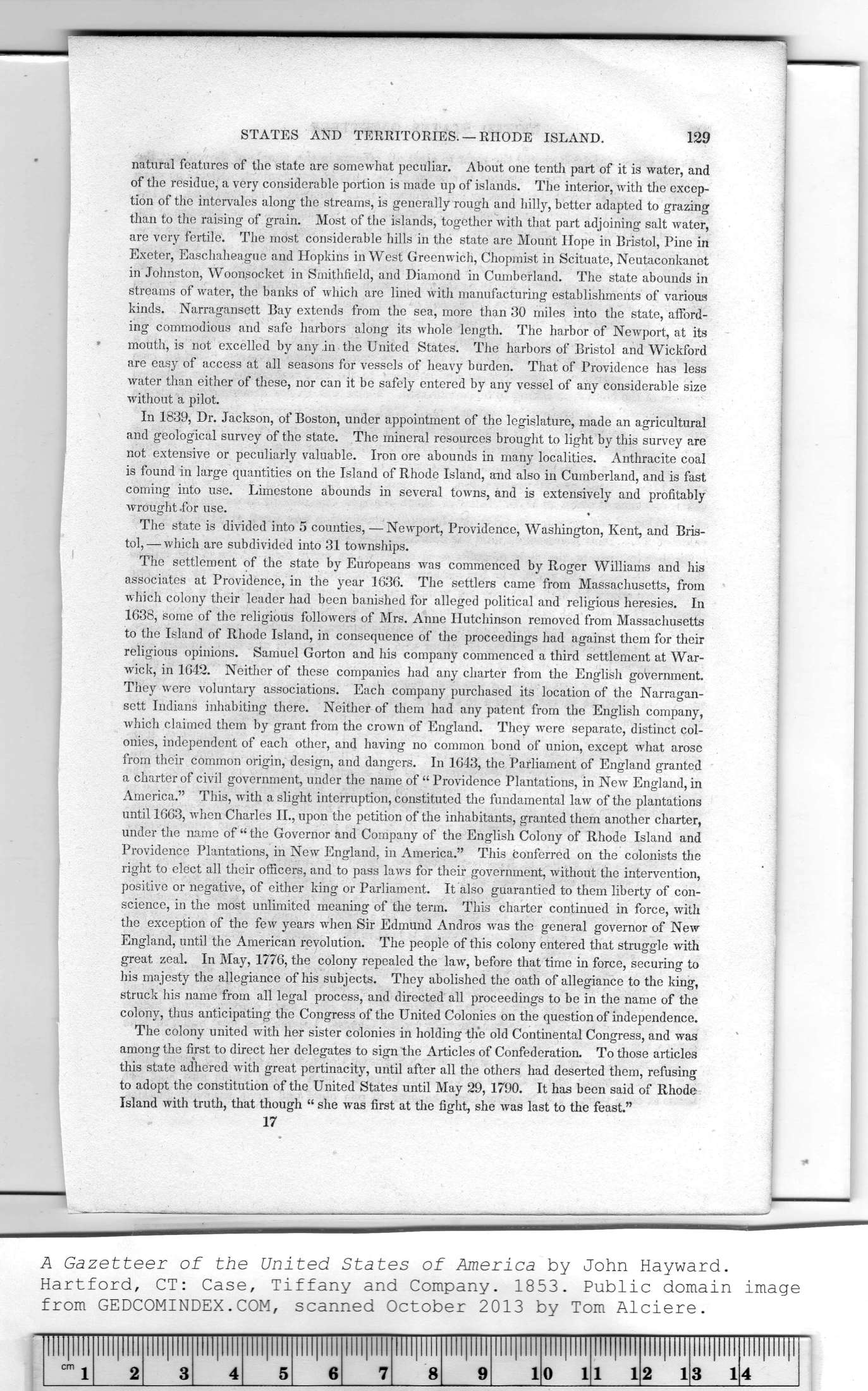|
|
Note: Ctrl and + increases the font size of the text below, Ctrl and - decreases it, and Ctrl and 0 resets it to default size.
STATES AND TERRITORIES. — RHODE ISLAND. 129
natural features of the state are somewhat peculiar. About one tenth part of it is water, and
of the residue, a very considerable portion is made up of islands. The interior, with the excep-
tion of the intervales along the streams, is generally rough and hilly, better adapted to grazing
than to the raising of grain. Most of the islands, together with that part adjoining salt water,
are very fertile. The most considerable hills in the state are Mount Hope in Bristol, Pine in
Exeter, Easchaheague and Hopkins in West Greenwich, Chopmist in Scituate, Neutaconkanet
in Johnston, Woonsocket in Smithfield, and Diamond in Cumberland. The state abounds in
streams of water, the banks of which are lined with manufacturing establishments of various
kinds. Narragansett Bay extends from the sea, more than 30 miles into the state, afford-
ing commodious and safe harbors along its whole length. The harbor of Newport, at its
mouth, is not excelled by any in the United States. The harbors of Bristol and Wickford
are easy of access at all seasons for vessels of heavy burden. That of Providence has less
water than either of these, nor can it be safely entered by any vessel of any considerable size
without a pilot.
In 1839, Dr. Jackson, of Boston, under appointment of the legislature, made an agricultural
and geological survey of the state. The mineral resources brought to light by this survey are
not extensive or peculiarly valuable. Iron ore abounds in many localities. Anthracite coal
is found in large quantities on the Island of Rhode Island, and also in Cumberland, and is fast
coming into use. Limestone abounds in several towns, and is extensively and profitably
wrought -for use.
The state is divided into 5 counties, — Newport, Providence, Washington, Kent, and Bris-
tol,— which are subdivided into 31 townships.
The settlement of the state by Europeans was commenced by Roger Williams and his
associates at Providence, in the year 1836. The settlers came from Massachusetts, from
which colony their leader had been banished for alleged political and religious heresies. In
1638, some of the religious followers of Mrs. Anne Hutchinson removed from Massachusetts
to the Island of Rhode Island, in consequence of the proceedings had against them for their
religious opinions. Samuel Gorton and his company commenced a third settlement at War-
wick, in 1642. Neither of these companies had any charter from the English government.
They were voluntary associations. Each company purchased its location of the Narragan-
sett Indians inhabiting there. Neither of them had any patent from the English company,
which claimed them by grant from the crown of England. They were separate, distinct col-
onies, independent of each other, and having no common bond of union, except what arose
from their common origin, design, and dangers. In 1643, the Parliament of England granted
a charter of civil government, under the name of “ Providence Plantations, in New England, in
America." This, with a slight interruption, constituted the fundamental law of the plantations
until 1663, when Charles II., upon the petition of the inhabitants, granted them another charter,
under the name of “ the Governor and Company of the English Colony of Rhode Island and
Providence Plantations, in New England, in America." This conferred on the colonists the
right to elect all their officers, and to pass laws for their government, without the intervention,
positive or negative, of either king or Parliament. It also guarantied to them liberty of con-
science, in the most unlimited meaning of the term. This charter continued in force, with
the exception of the few years when Sir Edmund Andros was the general governor of New
England, until the American revolution. The people of this colony entered that struggle with
great zeal. In May, 1776, the colony repealed the law, before that time in force, securing to
his majesty the allegiance of his subjects. They abolished the oath of allegiance to the king,
struck his name from all legal process, and directed all proceedings to be in the name of the
colony, thus anticipating the Congress of the United Colonies on the question of independence.
The colony united with her sister colonies in holding the old Continental Congress, and was
among the first to direct her delegates to sign the Articles of Confederation. To those articles
this state adhered with great pertinacity, until after all the others had deserted them, refusing
to adopt the constitution of the United States until May 29, 1790. It has been said of Rhode
Island with truth, that though “ she was first at the fight, she was last to the feast."
17
A Gazetteer of the United States of America by John Hayward.
Hartford, CT: Case, Tiffany and Company. 1853. Public domain image
|
